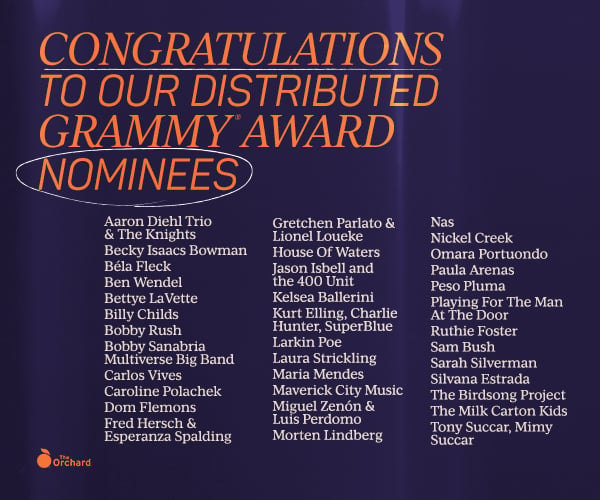The MBW Review is where we aim our microscope towards some of the music biz’s biggest recent goings-on. This time, we drill down into a remarkable set of numbers contained within MRC Data‘s new report on the US music industry in 2021. The MBW Review is supported by Instrumental.
UPDATE: The below analysis from MBW was based upon statistics that appeared in MRC Data’s end-of-year report for 2021, which was originally published on Thursday, January 6.
The following Monday (January 10), MRC Data reissued its end-of-year report with revised numbers for catalog vs. current consumption. These corrected figures differed substantially to the numbers that MRC initially published.
With this in mind, and in keenness not to mislead our readers, MBW has re-calculated our analysis based on MRC’s corrected full-year figures.
The short version: according to MBW analysis* based on these new MRC Data figures, catalog music claimed 73.1% of the US music consumption market in the second half of 2021.
Across the whole of 2021, says MRC Data’s revised report, catalog music actually claimed 69.8% of Total Album Consumption in the United States. (In its original 2021 report, MRC put this figure at 74.5%.)
You can see a simple table displaying MBW’s new calculations alongside MRC Data’s revised figures below, as well as a screengrab of the relevant section of MRC’s reissued report.
You can download the newly-revised MRC Data report (with the new sets of catalog vs. current numbers) through here.
[* MBW’s numbers are just that – our conclusions based on MRC’s published statistics. MRC Data has not endorsed our conclusions.]


The analysis as follows was published on January 6, based on the original version of MRC Data’s (now corrected) 2021 full-year report.
You couldn’t say that 2021 was light on blockbuster album releases.
There was Adele, of course, whose 30 raced out of the blocks in November to become 2021’s biggest-selling (as in, traditional album sales, not including streaming) album in the US.
In January, country artist Morgan Wallen released Dangerous: The Double Album, which was the US’s biggest album overall in 2021, as well as being its biggest in terms of streaming (with 3.65 billion audio streams alone).
There was also, to pick a few, Olivia Rodrigo’s Sour (the US’s No.2 biggest record in 2021), Drake’s Certified Lover Boy (No.3), and Doja Cat’s Planet Her (No.6).
We know all of this because of numbers contained in a new annual report released today (January 6) by US market monitor, MRC Data.
Yet we also know, thanks to that same report, that 2021’s biggest success story in the US had nothing to do with a new release: it was ‘catalog’ music.
According to MBW’s calculations using MRC’s numbers, ‘catalog’ records accounted for a stunning 82.1% of total recorded music consumption in the US in the second half of 2021.
You know what that must mean: ‘current’ records made up just 17.9% of US music consumption in the last six months of 2021… or less than a fifth of the market.
What’s more, total consumption (that’s sales plus streams) of ‘current’ music actually fell, in real terms, by 37.4% in the second half of 2021 compared to the same period of 2020.
Before we get into the nitty gritty, two important caveats:
- (i) Our 82.1% catalog figure refers to total music consumption across streaming and digital/physical sales; MRC doesn’t break out streaming-specific numbers on this topic.
- (ii) ‘Catalog’ music in MRC’s eyes counts as anything released over 18 months before a consumer made a purchase and/or pressed play. ‘Current’ music is in the inverse: any music released within the prior 18 months of the moment a consumer made a purchase and/or pressed play.
Still, the sheer scale of the streaming-driven dominance of catalog music in the US during 2021 will come as a shock to many in the music business.
After all, across the year of 2020, according to MRC’s report for that year, catalog claimed just 63.2% of the total US market.
Looking at the stats for just the second half of 2021, that figure had advanced by nearly 20%.
For the data fans out there, here’s how MBW got to our 82.1% figure for ‘catalog’ in H2 2021.
Last year, as you may recall, MRC Data released numbers which showed catalog music had claimed a (then-whopping-seeming!) 66.4% of the US record market in the first half of 2021.
Now, in its latest report, MRC Data has delivered fresh numbers for the whole calendar year, which shows catalog claimed 74.5% of the annual US market in 2021.

Obviously enough, getting from 66.4% in the first half of 2021 to 74.5% for the full year must have meant that in the second half of 2021, catalog’s share of the US market shot up.
And so it proves: According to MBW’s calculations using MRC’s numbers, the US saw ‘Total Album Consumption’ (TAC) of catalog records hit 376.7 million in the July-December 2021 period.
That’s 82.1% of the Total Album Consumption overall in this six month period, according to MRC’s data (434.7 million).
In the same six-month period (H2 2021), ‘current’ records claimed just 82.0 million TAC. That figure was down 37.4% YoY versus H2 2020.
You can see the full number breakdowns in the charts below, but it’s worth printing another little caveat first, explaining exactly how MRC Data calculates its TAC numbers (which cover both single tracks and albums, as well as streaming and sales).
MRC’s ‘total album consumption’ (TAC) metric bundles together physical and digital album sales with single-track downloads and (on-demand) streams, with these single-track downloads and streams converted into ‘album equivalent’ units. To achieve this, MRC converts every 1,250 premium streams or 3,750 ad-supported streams of tracks on an album into a single ‘sale’ for that LP. It does the same for every 10 downloads of tracks from a single album. This formula is designed to be ‘revenue reflective’ – for example, with 1,250 premium streams roughly generating the same amount of money as a single album.





So what’s driving such a huge jump in catalog’s share of the modern US record business?
One factor that can be inferred from MRC’s data is the theory that older consumers increasingly adopted music streaming during the Covid-era of 2021.
MRC’s research suggests that 89% of US listeners aged between 56 and 74 are now using streaming services to play music in the States.
That compares well to the equivalent figure for this age range in markets such as the UK (41%), Brazil (63%), and Germany (37%).

Elsewhere in MRC Data’s new report, the org further reveals that vinyl format saw sales increase 51.4% year-on-year in 2021, up to 41.7 million – a larger volume sum than annual CD sales (40.6m).
Whatever is driving older music’s mushrooming dominance of the US record industry, it’s not only affecting the market share of ‘catalog’ and ‘current’ records.
According to MRC’s report, sales/streams of ‘current’ records (i,e. those released in the previous 18 months) actually fell year-on-year in real terms, too:
- Across the entirety of 2020, says MRC, total album consumption (TAC) of ‘current’ records amounted to 269.3 million.
- Across the entirety of 2021, says the org, the equivalent figure amounted to just 228.1 million – a year-on-year decline of 15.3%.
Yet in the same 12 months of 2021, total on-demand streaming volume in the US increased 9.9% YoY to 1.13 trillion. And total album consumption (TAC) saw a YoY increase of 11.3%.
Set against the backdrop of this growing market, the shrinking presence of new music in the US record industry may leave some frontline record labels scratching their heads.
It may also, however, leave certain catalog music acquisition specialists grinning from ear to ear.






